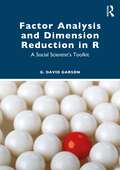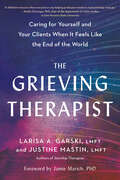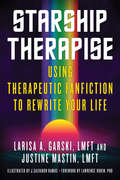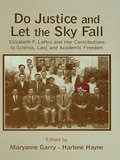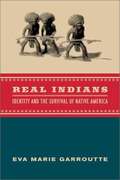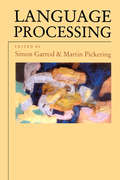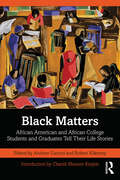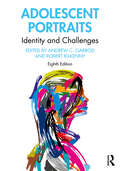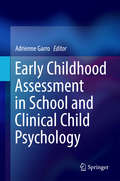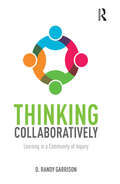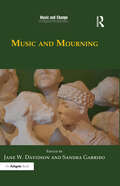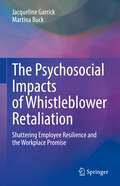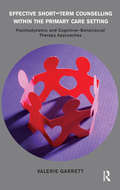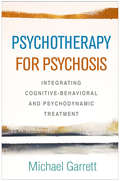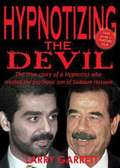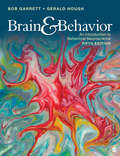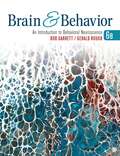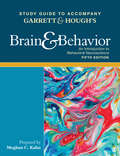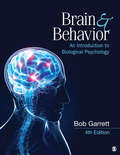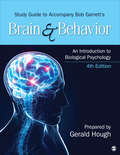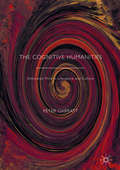- Table View
- List View
Factor Analysis and Dimension Reduction in R: A Social Scientist's Toolkit
by G. David GarsonFactor Analysis and Dimension Reduction in R provides coverage, with worked examples, of a large number of dimension reduction procedures along with model performance metrics to compare them. Factor analysis in the form of principal components analysis (PCA) or principal factor analysis (PFA) is familiar to most social scientists. However, what is less familiar is understanding that factor analysis is a subset of the more general statistical family of dimension reduction methods. The social scientist's toolkit for factor analysis problems can be expanded to include the range of solutions this book presents. In addition to covering FA and PCA with orthogonal and oblique rotation, this book’s coverage includes higher-order factor models, bifactor models, models based on binary and ordinal data, models based on mixed data, generalized low-rank models, cluster analysis with GLRM, models involving supplemental variables or observations, Bayesian factor analysis, regularized factor analysis, testing for unidimensionality, and prediction with factor scores. The second half of the book deals with other procedures for dimension reduction. These include coverage of kernel PCA, factor analysis with multidimensional scaling, locally linear embedding models, Laplacian eigenmaps, diffusion maps, force directed methods, t-distributed stochastic neighbor embedding, independent component analysis (ICA), dimensionality reduction via regression (DRR), non-negative matrix factorization (NNMF), Isomap, Autoencoder, uniform manifold approximation and projection (UMAP) models, neural network models, and longitudinal factor analysis models. In addition, a special chapter covers metrics for comparing model performance. Features of this book include: * Numerous worked examples with replicable R code * Explicit comprehensive coverage of data assumptions * Adaptation of factor methods to binary, ordinal, and categorical data * Residual and outlier analysis * Visualization of factor results * Final chapters that treat integration of factor analysis with neural network and time series methods Presented in color with R code and introduction to R and RStudio, this book will be suitable for graduate-level and optional module courses for social scientists, and on quantitative methods and multivariate statistics courses.
The Grieving Therapist: Caring for Yourself and Your Clients When It Feels Like the End of the World
by Larisa A. Garski Justine MastinFor readers of No Cure for Being Human and Simple Self-Care for Therapists, a witty and compassionate field guide to the 10 realms of grief--and how to navigate them yourself and with clients. How do you practice good therapy when it&’s the end of the world as we know it…and no one feels fine?The planet is burning, friends and family are falling to cults and QAnon, and we&’re all living through the collective trauma of a global pandemic. Among therapists and healers, burnout is rampant; hopelessness and despair are, too. In The Grieving Therapist, psychotherapists Larisa Garski, LMFT, and Justine Mastin, LMFT, give voice to the difficulties of therapising in today&’s world--and offer a grief-informed framework for taking care of yourself as you take care of others. Informed by narrative, internal family systems, fanfic, and trauma-sensitive therapy, Garski and Mastin examine what it means to be a therapist at the end of the world (or what feels like it). They break down 10 realms of grief that are critical to understand and work with today, but likely weren&’t taught to you in therapy school. Each chapter includes:Grieving tools that can be adapted for both client and therapistTips for supervisors and superviseesSkills for maintaining healthy outside-the-office relationshipsSupport for current therapy students (and therapists new to the field)Advice on how to hold space and work with clients who have the same questions—and are navigating the same issues—as youMeditations on love, life, death, and connectionGarski and Mastin also share helpful guidance around working with clients whose social or political beliefs differ from yours; when therapeutic self-disclosure makes sense; honoring the information that countertransference is trying to give you; and how to sit with (or step away from) triggers in your work.With humor, compassion, irreverence, and more than a little whimsy, The Grieving Therapist shows you how to show up for yourself, and your clients--in your own full humanity, amidst it all.
Starship Therapise: Using Therapeutic Fanfiction to Rewrite Your Life
by Larisa A. Garski Justine MastinHarnessing the power of fandom--from Game of Thrones to The Legend of Zelda--to conquer anxiety, heal from depression, and reclaim balance in mental and emotional health.Modern mythologies are everywhere--from the Avengers of the Marvel Cinematic Universe to the dragons of Game of Thrones. Where once geek culture was niche and hidden, fandom characters and stories have blasted their way into our cineplexes, bookstores, and streaming systems. They help us make sense of our daily lives--and they can also help us heal. Mental health therapists and Starship Therapise podcast hosts Larisa A. Garski and Justine Mastin offer a self-help guide to the mental health galaxy for those who have been left out in more traditional therapy spaces: geeks, nerds, gamers, cosplayers, introverts, and all of their friends.Starship Therapise explores the ways in which narratives and play inform the shape of our lives, inviting readers to embrace radical self-care with lessons from Westworld's Maeve and Dolores, explore anxiety with Miyazaki, and understand narrative therapy with Arya Stark. Spanning fandom from Star Wars to Harry Potter, The Legend of Zelda to Steven Universe, and everywhere in between, Starship Therapise is an invitation to explore mental health and emotional wellness without conforming to mainstream social constructions.Insights from comics like Uncanny X-Men, Black Panther, Akira, Bitch Planet, The Wicked + Divine, and Batman offer avenues to growth and self-discovery alongside explorations of the triumphs and trials of heroes, heroines, and beloved characters from Star Wars, Wuthering Heights, The Lord of the Rings, The Broken Earth trilogy, Mass Effect, Fortnite, Minecraft, Buffy the Vampire Slayer, and Star Trek. Each chapter closes with a hands-on mindfulness, meditation, or yoga exercise to inspire reflection, growth, and the mind-body-fandom connection.
Do Justice and Let the Sky Fall: Elizabeth F. Loftus and Her Contributions to Science, Law, and Academic Freedom (Psychology Press Festschrift Series)
by Maryanne Garry Harlene HayneFor more than 30 years, renowned psychological scientist Elizabeth F. Loftus has contributed groundbreaking research to the fields of science, law, and academia. This book provides an opportunity for readers to become better acquainted with one of the most important psychologists of our time, as it celebrates her life and accomplishments. It is intended to be a working text-one that challenges, intrigues, and inspires all readers alike. Do Justice and Let the Sky Fall collects research in theoretical and applied areas of human memory, provides an overview of the application of memory research to legal problems, and presents an introduction to the costs of doing controversial research. The first chapter gives a sketch of Loftus' career in her own words, and the remaining chapters color in that sketch. The final chapters of the book are more personal, and put a human face on a person who is held in such high esteem. This multipurpose volume is intended to serve as a valuable resource for established scientists, emerging scientists, graduate students, lawyers, and health professionals.
Real Indians: Identity and the Survival of Native America
by Eva Marie GarroutteAn insightful and original analysis of the competing ways that Indian identity is defined, followed by a discussion of a new way of defining Indian-ness, which the author calls "indigenous theory."
Language Processing (Studies in Cognition)
by Simon Garrod Martin J. PickeringLanguage Processing questions what happens when we process language - what mental operations occur during processing and how they are organised over time. The last decade has seen real advances in the study of language processing that have wide ranging implications for human cognition in general. Language Processing gives an account of these developments both as they relate to experimental studies of processing and as they relate to computational modelling of the processes. In addition to chapters covering core topics, such as lexical processing, syntactic parsing and the comprehension of discourse, special topics of recent interest are also included.
Black Matters: African American and African College Students and Graduates Tell Their Life Stories
by Andrew Garrod Robert KilkennyBlack Matters presents an anthology of stories of African American and African undergraduate and graduate students’ experiences at college, offering lifespan perspectives on their formative relationships and influences, life-changing events, and the role their heritage has played in shaping their personal identities, values, and choices. Andrew Garrod and Robert Kilkenny bring together contributors who share personal memoirs reflecting on their experience of navigating life on campus as students of Dartmouth College, New Hampshire. The ten brave authors, six Black men and four Black women, present thoughtful, often emotional, accounts of moments that transformed their academic, professional, and racial identities. Supplemented by follow-up accounts of four of the graduates, the text underlines developmental perspectives whilst examining what has remained the same about their lives and values, and what has changed over time. The collection explores the notion of hard work and "grit" in overcoming discrimination, racism, and adversity, and how in reality college students who are not part of the racial/cultural majority must contend with the normative identity challenges of late adolescence while carrying the extra burden of "two-ness". Featuring an introduction by Chanté Mouton Kinyon, this anthology examines crucial topics including classroom experience; intellectual stimulation and learning environment; interactions with African American and African students; friendships that crossed the lines of race, ethnicity, class, gender, and sexual orientation, and how collegiate life affects issues related to personal and racial identities. The rich narratives in Black Matters provide vital insight into the relationship between collegiate experiences and racial identities. It will be essential reading for students and scholars of psychology, education, cultural anthropology, sociology and creative writing, as well as for those responsible for campus climate and student experience.
Adolescent Portraits: Identity and Challenges
by Andrew C. GarrodAdolescent Portraits introduces contemporary theories and research that surround adolescent development today through eighteen first-person accounts written by young adults. The case study approach of the book illustrates the complexity of the individual experience and the interactions among an individual’s needs, ideas, relationships, and context. Each case, taken alone, helps us begin to know one more adolescent and his or her experience; taken together, the cases provide a rich overview of the wide, diverse, and complex range of adolescent experiences. This edition also includes three follow-up essays, written five or more years after their original memoir. The authors of these follow-ups reflect on their original story written in late adolescence from the more mature point of view of full-fledged adulthood. These retrospectives provide a poignant and lifespan developmental perspective on the ways in which the adolescent themes of identity and challenges transform, for better or worse, with the tasks of adulthood. With contributions from adolescents from a range of racial, class, and family backgrounds, the book provides a diverse introduction to the adolescent experience. It is a must-read for any student of adolescent development.
Early Childhood Assessment in School and Clinical Child Psychology
by Adrienne GarroThis book presents an integrated and coordinated framework for assessing developmental, psychological, and behavioral disorders in early childhood. Expert contributors advocate for natural-environment methods in addition to standardized measures in assessing academic and social skills as well as age-specific behavior problems in young children. Chapters model collaborations between clinicians, family, and daycare and school personnel, address diagnostic and classification issues, and conceptualize assessment as flexible, ongoing, and, as necessary, leading to coordinated services. The book gives practitioners and researchers critical tools toward establishing best practices in an increasingly complex and important area, leading to better prevention and intervention outcomes. Included in the coverage: Standardized assessment of cognitive development. Authentic and performance-based assessment. The use of Response to Intervention (RTI) in early childhood. Collaboration in school and child care settings. Anxiety disorders, PTSD, OCD, and depression in young children. Sleeping, feeding/eating, and attachment problems in early childhood. Early Childhood Assessment in School and Clinical Child Psychology is an essential resource for clinicians and related professionals, researchers, and graduate students in child and school psychology; assessment, testing, and evaluation; occupational therapy; family studies, educational psychology; and speech pathology.
Thinking Collaboratively: Learning in a Community of Inquiry
by D. Randy GarrisonThinking Collaboratively is a theoretical and practical guide to thinking and learning in deep and meaningful ways within purposeful communities of inquiry. Critical thinking has long been recognized as an important educational goal but, until now, has largely been conceived and operationalized as an individual attitude and ability. Increasingly, however, a more relevant and complete cognitive construct has been emerging: thinking collaboratively. Thinking collaboratively is the means to inquire, test, and apply new understandings, and to make sense of the information that bombards us continuously. In short, thinking collaboratively is required to flourish in our highly connected world and, in this book based on more than a decade of research, Garrison provides an essential introduction to this vital concept.
Music and Mourning (Music and Change: Ecological Perspectives)
by Sandra Garrido Jane W. DavidsonWhile grief is suffered in all cultures, it is expressed differently all over the world in accordance with local customs and beliefs. Music has been associated with the healing of grief for many centuries, with Homer prescribing music as an antidote to sorrow as early as the 7th Century BC. The changing role of music in expressions of grief and mourning throughout history and in different cultures reflects the changing attitudes of society towards life and death itself. This volume investigates the role of music in mourning rituals across time and culture, discussing the subject from the multiple perspectives of music history, music psychology, ethnomusicology and music therapy.
Why Are We Attracted to Sad Music?
by Sandra GarridoIn this book, perspectives in psychology, aesthetics, history and philosophy are drawn upon to survey the value given to sad music by human societies throughout history and today. Why do we love listening to music that makes us cry? This mystery has puzzled philosophers for centuries and tends to defy traditional models of emotions. Sandra Garrido presents empirical research that illuminates the psychological and contextual variables that influence our experience of sad music, its impact on our mood and mental health, and its usefulness in coping with heartbreak and grief. By means of real-life examples, this book uses applied music psychology to demonstrate the implications of recent research for the use of music in health-care and for wellbeing in everyday life.
The Psychosocial Impacts of Whistleblower Retaliation: Shattering Employee Resilience and the Workplace Promise
by Jacqueline Garrick Martina BuckThis book analyzes the harms related to whistleblower retaliation, its psychosocial impacts on employees, and the institutional dysfunction it creates and perpetuates. Stigma and biases against whistleblowers interfere with their ability to make protected disclosures when harm to others is at stake. Retaliatory toxic tactics create an atmosphere and corporate culture that embodies fear and encourages bystander behavior. In this book, the authors explore psychosocial impacts across domains that include financial, legal, social, physical, and emotional well-being. Ten of the 14 chapters specifically examine the toxic tactics of retaliation: gaslighting, mobbing, marginalizing, shunning, devaluing, double-binding, career blocking, counter-accusing, bullying, and doxxing. These toxic tactics are the building blocks of workplace traumatic stress (WTS) and can lead to posttraumatic stress disorder (PTSD), depression, substance abuse, and suicide. WTS is a term that differentiates between workplace violence or job stress, which can be components of WTS but do not fully describe the systemic hostile work environment that targets an employee. Understanding WTS and how it disrupts identity, causes moral injury, and shatters world views are important aspects for clinicians treating clients who are victims of this kind of hostile work environment. The Psychosocial Impacts of Whistleblower Retaliation is a useful resource offering a new way for social workers, mental health providers, advocates, and other support services professionals and practitioners to assist whistleblowers. It helps clinicians understand how to view patients suffering from whistleblower retaliation and gives them a lexicon for forensic evaluations. Lawyers, especially those specializing in employment, labor, and Qui Tam cases, also could benefit from having a means to describe the psychosocial impacts of retaliation and WTS on their clients when filing for compensatory damages for pain and suffering during judicial proceedings. Finally, the book could appeal to employees and managers, human resources professionals, victim rights advocates, elected officials, media personnel, and other professionals who are interested in learning more about whistleblower retaliation and its psychosocial and cultural implications.
Effective Short-Term Counselling within the Primary Care Setting: Psychodynamic and Cognitive-Behavioural Therapy Approaches
by Valerie GarrettThis book covers two distinct yet related topics: the primary care setting and the counselling carried out within it, and it can be dipped into or read straight through. Part One, using psychodynamic and systems theory, explores the holding environment of primary care, the interpersonal relationships within the primary care team, and other variables affecting counselling in a medical organisational setting. Part Two takes the counsellor through the 'how' of using psychodynamic and Cognitive-Behavioural Therapy (CBT) approaches within short-term contracts in this setting. Case studies and scenarios are given to illustrate these. The counsellor is guided through assessing the patient's counselling needs either within a psychodynamic or CBT model or to formulate a 'tailor-made' short-term contract, using elements drawn from psychodynamic, CBT, and supportive counselling.
Psychotherapy for Psychosis: Integrating Cognitive-Behavioral and Psychodynamic Treatment
by Michael GarrettIn this innovative book, master clinician Michael Garrett shows how to weave together cognitive-behavioral therapy (CBT) and psychodynamic therapy to support the recovery of persons suffering from psychosis. This integrated framework builds on the strengths of both methods to achieve lasting gains, even for patients with severe, chronic mental illness. The therapist is guided to use CBT to help the patient recognize the literal falsity of delusions, while employing psychodynamic strategies to explore the figurative truth and personal meaning of psychotic symptoms. Extended case presentations and numerous clinical vignettes illustrate Garrett’s compassionate, empowering approach.
Hypnotizing the Devil: The True Story of a Hypnotist Who Treated the Psychotic Son of Saddam Hussein
by Larry GarrettEveryone remembers where they were during the September 11 attacks in New York. Larry Garrett, a Chicago hypnotist will never forget, since he was in Saddam Husseins palace in Baghdad with Uday Hussein, Saddams eldest son. After an assassination attempt on Udays life, Larry Garrett was brought in to help with the recovery from the mental and physical pain. Larry writes about his account of dealing with the man often referred to as a psychopath, the CIA, a palace full of guards with machine guns, and visiting Babylon. The conversations about American culture and Uday Hussein's very surprising views, to getting the behind the scenes account at the palace as a World War begins. Larrys account of being the only American allowed into Iraq and hypnotizing the son of the most feared family in the World, will keep you in suspense. Larry Garrett has been in practice since 1968, operating the largest hypnosis centre in Chicago. He has received nationwide recognition for his outstanding contributions in hypnosis, including the 1991 Metzinger Award (which has only been presented six times) for contributions to the field of hypnosis.
Brain & Behavior: An Introduction to Behavioral Neuroscience
by Bob Garrett Gerald HoughIgnite your excitement about behavioral neuroscience with Brain & Behavior: An Introduction to Behavioral Neuroscience, Fifth Edition by best-selling author Bob Garrett and new co-author Gerald Hough. Garrett and Hough make the field accessible by inviting readers to explore key theories and scientific discoveries using detailed illustrations and immersive examples as their guide. Spotlights on case studies, current events, and research findings help readers make connections between the material and their own lives. A study guide, revised artwork, new animations, and an accompanying interactive eBook stimulate deep learning and critical thinking.
Brain & Behavior: An Introduction to Behavioral Neuroscience
by Bob Garrett Gerald HoughIgnite your excitement about behavioral neuroscience with Brain & Behavior: An Introduction to Behavioral Neuroscience, Fifth Edition by best-selling author Bob Garrett and new co-author Gerald Hough. Garrett and Hough make the field accessible by inviting readers to explore key theories and scientific discoveries using detailed illustrations and immersive examples as their guide. Spotlights on case studies, current events, and research findings help readers make connections between the material and their own lives. A study guide, revised artwork, new animations, and an accompanying interactive eBook stimulate deep learning and critical thinking.
Brain & Behavior: An Introduction to Behavioral Neuroscience
by Bob Garrett Gerald HoughWinner of the 2022 Textbook & Academic Authors Association′s The McGuffey Longevity Award In Brain & Behavior: An Introduction to Behavioral Neuroscience, authors Bob Garrett and Gerald Hough showcase the ever-expanding body of research into the biological foundations of human behavior through a big-picture approach. With thought-provoking examples and a carefully crafted, vibrant visual program, the text allows any student to appreciate the importance and relevance of this field of study. New features to the Sixth Edition include fully revised learning objectives, a streamlined box feature program, an expanded collection of foundational animations, and updated research on timely topics such as drugs and addiction, sex and gender, and emotions and health. This title is accompanied by a complete teaching and learning package. Digital Option / Courseware SAGE Vantage is an intuitive digital platform that delivers this text’s content and course materials in a learning experience that offers auto-graded assignments and interactive multimedia tools, all carefully designed to ignite student engagement and drive critical thinking. Built with you and your students in mind, it offers simple course set-up and enables students to better prepare for class. Assignable Video with Assessment Assignable video (available with SAGE Vantage) is tied to learning objectives and curated exclusively for this text to bring concepts to life. LMS Cartridge Import this title’s instructor resources into your school’s learning management system (LMS) and save time. Don’t use an LMS? You can still access all of the same online resources for this title via the password-protected Instructor Resource Site.
Brain & Behavior: An Introduction to Behavioral Neuroscience
by Bob Garrett Gerald HoughWinner of the 2022 Textbook & Academic Authors Association′s The McGuffey Longevity Award In Brain & Behavior: An Introduction to Behavioral Neuroscience, authors Bob Garrett and Gerald Hough showcase the ever-expanding body of research into the biological foundations of human behavior through a big-picture approach. With thought-provoking examples and a carefully crafted, vibrant visual program, the text allows any student to appreciate the importance and relevance of this field of study. New features to the Sixth Edition include fully revised learning objectives, a streamlined box feature program, an expanded collection of foundational animations, and updated research on timely topics such as drugs and addiction, sex and gender, and emotions and health. This title is accompanied by a complete teaching and learning package. Digital Option / Courseware SAGE Vantage is an intuitive digital platform that delivers this text’s content and course materials in a learning experience that offers auto-graded assignments and interactive multimedia tools, all carefully designed to ignite student engagement and drive critical thinking. Built with you and your students in mind, it offers simple course set-up and enables students to better prepare for class. Assignable Video with Assessment Assignable video (available with SAGE Vantage) is tied to learning objectives and curated exclusively for this text to bring concepts to life. LMS Cartridge Import this title’s instructor resources into your school’s learning management system (LMS) and save time. Don’t use an LMS? You can still access all of the same online resources for this title via the password-protected Instructor Resource Site.
Study Guide to Accompany Garrett & Hough's Brain & Behavior: An Introduction to Behavioral Neuroscience
by Bob Garrett Gerald HoughCompletely revised to accompany the best-selling Brain & Behavior: An Introduction to Behavioral Neuroscience, Fifth Edition, the Study Guide offers students even more opportunities to review, practice, and master course material. Featuring chapter outlines, learning objectives, summaries and guided reviews, short answer and essay questions, multiple choice post-test questions, and answer keys, the guide reflects important updates made to the content in the main text to enhance student understanding.
Study Guide to Accompany Garrett & Hough's Brain & Behavior: An Introduction to Behavioral Neuroscience
by Bob Garrett Gerald HoughCompletely revised to accompany the best-selling Brain & Behavior: An Introduction to Behavioral Neuroscience, Fifth Edition, the Study Guide offers students even more opportunities to review, practice, and master course material. Featuring chapter outlines, learning objectives, summaries and guided reviews, short answer and essay questions, multiple choice post-test questions, and answer keys, the guide reflects important updates made to the content in the main text to enhance student understanding.
Brain & Behavior: An Introduction to Biological Psychology
by Bob GarrettThe Fourth Edition of Brain & Behavior: An Introduction to Biological Psychology by Bob Garrett showcases our rapidly increasing understanding of the biological foundations of behavior, engaging students immediately with easily accessible content. Bob Garrett uses colorful illustrations and thought-provoking facts while maintaining a “big-picture” approach that students will appreciate. Don’t be surprised when they reach their “eureka” moment and exclaim, “Now I understand what was going on with Uncle Edgar!” “ [T]he topic coverage is excellent. It is what a student taking an Introductory Biological Psychology course should walk away with.” —William Meil, Indiana University of Pennsylvania “I absolutely love this book. I think it is head and shoulders above any other.… The book is just right. I have used every edition so far and students seem to read it and grasp the concepts well. It is clearly written, well illustrated, and explains concepts in an engaging and understandable way. The text reads like it should—a wonderfully written book. It almost reads like a novel, progressing through the topics with a fluency that is rare. It’s perfect for my students.” —Carol L. DeVolder, St. Ambrose University “The text is well organized and has excellent artwork depicting complex brain functions.” —Dr. Catherine Powers Ozyurt, Bay Path College “Excellent use of artwork, good coverage of a range of topics within each chapter.” —M. Foster Olive, Arizona State University
Study Guide to Accompany Bob Garrett’s Brain & Behavior: An Introduction to Biological Psychology
by Bob GarrettRevised by Gerald Hough to accompany the Fourth Edition of Bob Garrett’s best seller, Brain & Behavior: An Introduction to Biological Psychology, the fully updated Student Study Guide provides additional opportunities for student practice and self-testing. Featuring helpful practice exercises, short answer/essay questions, as well as post-test multiple choice questions, the guide helps students gain a complete understanding of the material presented in the main text. Save your students money! Bundle the guide with the main text. Use Bundle ISBN: 978-1-4833-1832-5. The main text, Brain & Behavior: An Introduction to Biological Psychology, Fourth Edition, showcases our rapidly increasing understanding of the biological foundations of behavior, engaging students immediately with easily accessible content. Bob Garrett uses colorful illustrations and thought-provoking facts while maintaining a “big-picture” approach that students will appreciate. Don’t be surprised when they reach their “eureka” moment and exclaim, “Now I understand what was going on with Uncle Edgar!”
The Cognitive Humanities: Embodied Mind in Literature and Culture
by Peter GarrattThis book identifies the ‘cognitive humanities’ with new approaches to literature and culture that engage with recent theories of the embodied mind in cognitive science. If cognition should be approached less as a matter of internal representation—a Cartesian inner theatre—than as a form of embodied action, how might cultural representation be rethought? What can literature and culture reveal or challenge about embodied minds? The essays in this book ask what new directions in the humanities open up when the thinking self is understood as a participant in contexts of action, even as extended beyond the skin. Building on cognitive literary studies, but engaging much more extensively with ‘4E’ cognitive science (embodied, embedded, enactive, extended) than previously, the book uses case studies from many different historical settings (such as early modern theatre and digital technologies) and in different media (narrative, art, performance) to explore the embodied mind through culture.
